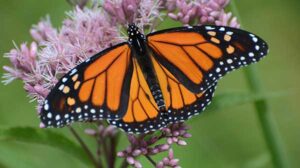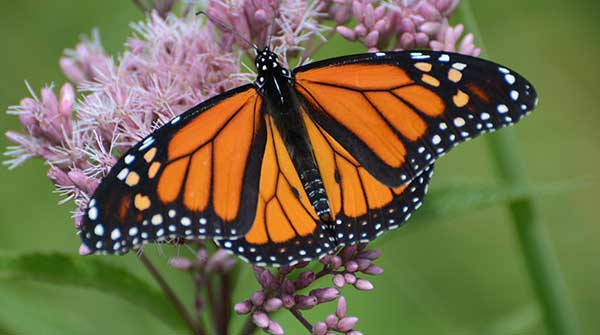Why do billions of birds, insects and animals head south for winter?
 Well, let’s see – the days are gorgeous, the nights longer and colder, the winds come from the north more and more – what could be going on?
Well, let’s see – the days are gorgeous, the nights longer and colder, the winds come from the north more and more – what could be going on?
Ah – it’s autumn again, and with it comes the exodus of billions (yes, you read that correctly) of birds and other animals heading to the Tropics.
Many will stop in the southern U.S., more will travel to Central America, and a surprisingly large number will make it all the way to South America! The trials they face are incredible as they encounter threats from aerial and terrestrial predators, buildings and vehicle impacts, hunters, pesticides, wires – well, you get the idea. But many, in fact most, will make it to their southern homes.
Why do I call it home, you might ask? Aren’t these ‘our’ birds, mammals and insects since they breed here? Sort of, but they actually only spend about a third of the year here and the rest of the time in transit or in the south. So you decide who ‘owns’ them.
 Monarch butterfly |
 Green Darner dragonfly |
| Related Stories |
| Exploring the secret lives of Canada’s snakes
|
| Where do fish go in the winter?
|
| How to read animal tracks in the snow
|
But birds aren’t the only animals to travel. Many other animals migrate, and all for the same reason – generally not to find shelter or avoid predators, but rather to find fresh food resources. The migration of millions of wildebeests in Africa is well-known, as are the massive caribou migrations in northern Canada. But did you know that insects and bats migrate as well?
As insect-eaters, bats undertake widespread migrations to escape our cold shores and travel to southern areas. Many of our species leave, including Red, Hoary and Silver-haired Bats. Others will weather the storm, so to speak, and overwinter in our houses or in caves.
The most obvious of the insect migrations is the Monarch Butterfly that migrates from here to Mexico. That’s an incredible feat for such a dainty creature. Tiny, tattered wings are often evident once they reach their wintering grounds.
When they begin their journey north next year, it will take several generations to reach our fields, while it only took one generation to get to the wintering grounds. Other migrating butterflies include American Snout, Painted & American Ladies, Red Admiral, Common Buckeye, Orange Sulphur, Gray Hairstreak and Question Mark. In India alone, over 250 species of butterflies migrate. Some moths also migrate, such as an interesting one called the Eurasian Hummingbird Hawk-moth that migrates from South Asia and Africa to Europe and North Asia.
Other insects that migrate include locusts and short-horned grasshoppers, which will occasionally swarm and move thousands of kilometres in vast numbers. Several members of various dragonfly families migrate as well. The best-known one in North America is the Green Darner, a large dragonfly that flies rapidly southward along traditional routes used by birds of prey such as Kestrels and Merlins. These falcons, in fact, feed on these meaty morsels as they migrate alongside them. So, while the dragonflies are gobbling small prey on their journey, they become dinner for these winged apex predators. Several other kinds of dragonflies migrate as well, including Black Saddlebags and Variegated Meadowhawk, a smallish reddish insect.
The Wandering Glider (a.k.a. Globe Glider or Globe Skimmer) is another insect that migrates vast distances. They are known to travel as much as 18,000 kilometres over all continents except Antarctica in their annual journeys. Some Milkweed Bugs also undertake north-south migrations from southern Canada to the south of the U.S.
Migration is complex and can be a bit confusing. Did the animal leave to escape the cold, or is it simply moving between locations to pursue fresh food sources? Quite honestly, it doesn’t matter to me what you call it or what motive you apply to these incredible annual movements. It is always fascinating how they know when and where to go.
I guess one new challenge they face is the rapid and frequent changes to weather that accompany climate change. Some of these will result in range expansions – others will decline. But throughout, the migrations will continue. Now is the time to experience the wonder of mammal, bird and insect migration, for it is in full swing!
Geoff Carpentier is a published author, expedition guide and environmental consultant.
For interview requests, click here.
The opinions expressed by our columnists and contributors are theirs alone and do not inherently or expressly reflect the views of our publication.
© Troy Media
Troy Media is an editorial content provider to media outlets and its own hosted community news outlets across Canada.


